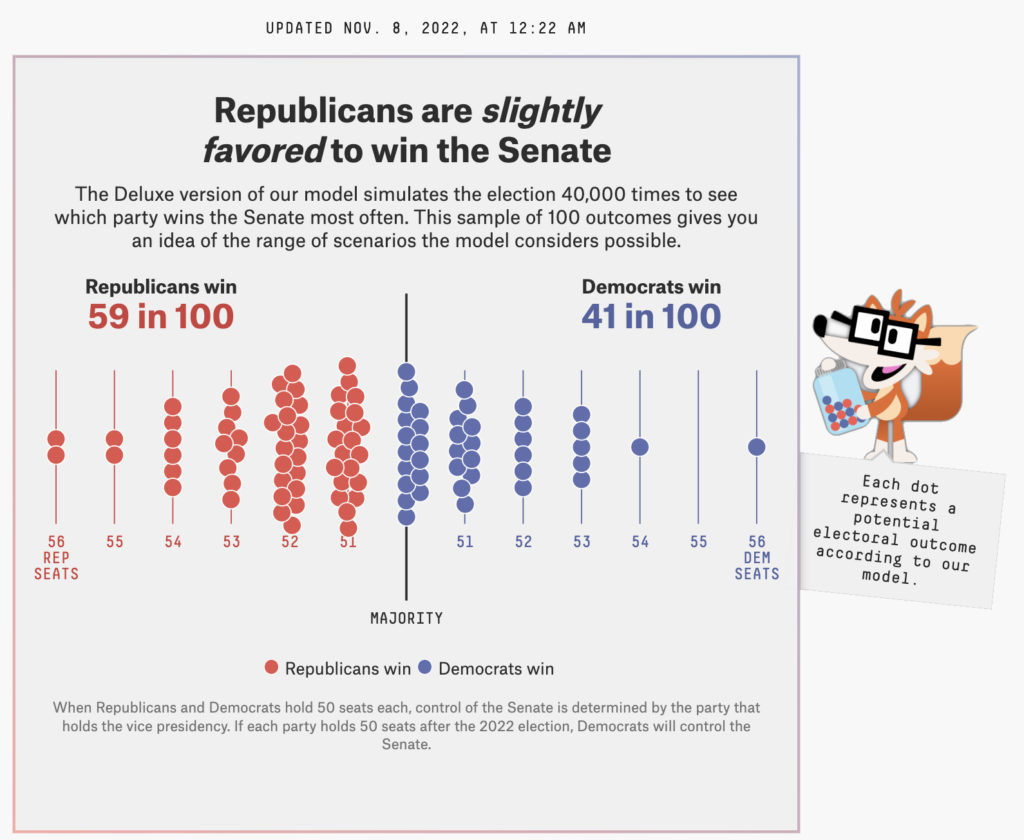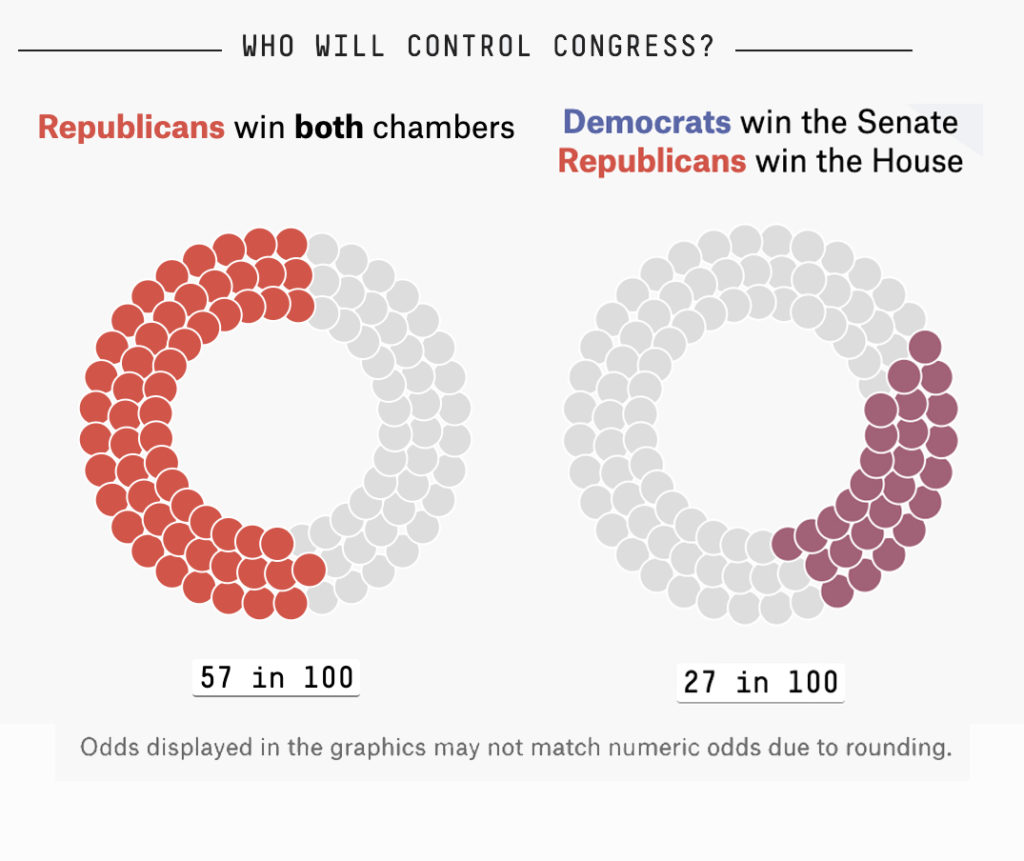Deja blew it: How pollsters misled the media — and the media misled voters
Voters of America! Pundits of journalism! My fellow reporters! If it seems we’ve been here before, it’s because we have. And we have. And we have again.
First, the current events. With Election day come and gone, it’s a good time to take a look at how the pollsters fared in calling one of the important elections in American history — where election deniers, fans of authoritarian rule and doomsday prophets threatened to hijack our democracy and point us square in the direction of the United States of Viktor Orbán.
I’ll concentrate on the 800-pound polling gorilla, FiveThirtyEight. Here’s how they called the balance of power in Congress based on 40,000 simulations and as of Election Day itself:

Barking up the wrong poll
Now let’s turn back the clock two years to another barnburner of an election that held critical implications for not only our national leadership but also the future of democracy itself. As one analyst concluded, there was “a failure across the political universe” as the polling intelligentsia failed to nail voting tallies in the House, Senate and even the presidential race, where Joe Biden’s seeming 10 percent lead was not nearly so assailable as they asserted. How many discouraged GOP voters who believed FiveThirtyEight and their ilk gave up and stayed home?
Thus I wrote a fairly scathing op-ed on how FiveThirtyEight and its (occasionally foul-mouthed) czar Nate Silver royally dropped the political football in forecasting how the U.S. elections would turn out. As I wrote back then:
Following Election Day 2020, Silver got defensive. Fox reported that on his political podcast, he fired back at his critics: “If they’re coming after FiveThirtyEight, then the answer is, f–k you, we did a good job.”
Hmm. Sounds fairly Trumpian to me.
In fact, here’s The Donald himself talking about his hand-picked slate of Republican candidates in last month’s midterms, as told to NewsNation’s Markie Martin:
“Well, I think if they win, I should get all the credit, and if they lose, I should not be blamed at all.”
And yet, another constituency deserves as much blame for the 2022 clusterfudge forecasts as the pollsters. And that’s the media itself.
When reporters rely on polls full of holes
My question is this: Given the remarkable string of polling fails, why do we in the media give even a second’s attention to pollsters anymore? Reporters are rigorously trained (or at least were once upon a time) to know that context is everything. If the Bozo Institute tells us that 7 of ten doctors recommend aspirin to, say, cure cancer, then the obvious next question should be: How many times did those bozos miss the target entirely in their last ten proclamations? And really, how reliable are they?
What’s more, numbers can be fudged, deep faked and cooked in a way to make Enron accountants blush — more than ever, in fact.
But let’s assume the numbers are right, and that FiveThirtyEight used accurate data in its forecasts. Then other foundational questions come into play:
- How relevant were those data points?
- How static as opposed to fluid?
- How much did they account for the milieu (the overturning of Roe V. Wade) as opposed to the candidate?
- And: How much did they take into account the fact that everyone at some point “abandons the shopping cart” at the last minute and reverses their stated intention?
That final phenomenon, arguably the most relevant, is well documented in the bestseller The Human Element: Overcoming the Resistance That Awaits New Ideas. Authors Loran Nordgren and David Schonthal are professors at Northwestern University’s Kellogg School of Management. I assume these men know their numbers very well.
Why some journos can’t stop acting like caveman
Here’s another point of human nature: Ever since the first Neanderthal wagered the first slab of raw meat on the first fist fight between knuckle draggers, humans have loved a good wager and the tension of an unknown outcome.
Yet proto-humans also hated uncertainty. Humans today still do. And since turning to shamans and clairvoyants isn’t exactly en vogue in this digital age, we embrace pollsters as soothsayers of algorithmic truth.
But if it’s numbers we’re going to worship, who’s analyzing the percentage of times polls fall well outside the so-called margin of error? Or even on a coin-toss basis, how often they can’t pick accurately between a loss and a win?
I’ll repeat what I said in 2020, because it’s just as important to grasp today:
Polls don’t just report information. … They influence outcomes. It creates a feedback loop. Maybe that’s not the intention. But it sure as hell is a consequence.
And as in 2020, reaction to the 2022 FiveThirtyEight fail was swift and spot-on, per its own comment section. Here are just two I plucked in all of 30 seconds:
The stories coming out of 538 seem to be ignoring the elephant in the room. Their forcast and polling in general failed us miserably once again. Where do we go from here?
Just how wrong are you lot over there? I don’t even know who you guys talked to in your “polls,” but maybe find another line of work.
I should say. How come nobody polled these people?
About that new line of work…
Look, I could do/fake this polling job. Really, I could. A comrade in financial journalism once suggested — cynically, for sure — how I could elevate my standing in this profession as a prognosticator. He compared it to how stock pundits such as Jim Cramer make a zillion calls but only have to get one bullseye — which they promote the living daylights out of once it materializes.
Never mind that Cramer made perhaps the worst stock call in history in 2008 when he urged his followers to hold onto Bear Stearns stock just before the company executed a crash-and-burn for the ages. He had to apologize just recently when he trumpeted Meta stock prior to a massive, massive drop in share price. He blows it, nest eggs scatter to the winds.
But if you’re Cramer or Silver, why the hell worry? Just wait for it to blow over and return in a few with your chest-puffing best. Strut it like Lady Gaga live at the Grammys. Let your style and bluster blind people to your thin substance.
Or take a page from TV weathermen and their more degreed colleagues, the meteorologists. Before today’s computer modeling, not a single one ever got canned for being accurate on just an occasional basis. Plumbers, surgeons, architects, accountants and yes, journalists: All historically have faced tremendous pressure to nail it near 100 percent of the time or else find another line of work.
The same can’t be said of political pollsters, who are making a good argument for having their profession classified as pseudoscience.
Meanwhile … the big trouble is this:
When journalists rely on the pollsters, we get it wrong, too. In an age when the best of us are trying to kick the fake news label to the curb, it will damage our credibility and trustworthiness.
This fearless forecast, I would submit, needs no margin of error — not in a profession, a calling, where our margin of error must be slim to none.
Lou Carlozo is the Editor and Publisher of Talking Biz News, and Qwoted’s Editor in Chief. All views expressed are a tongue stuck to a frozen poll. Email lou@qwoted.com or connect on LinkedIn.
POPULAR POSTS

